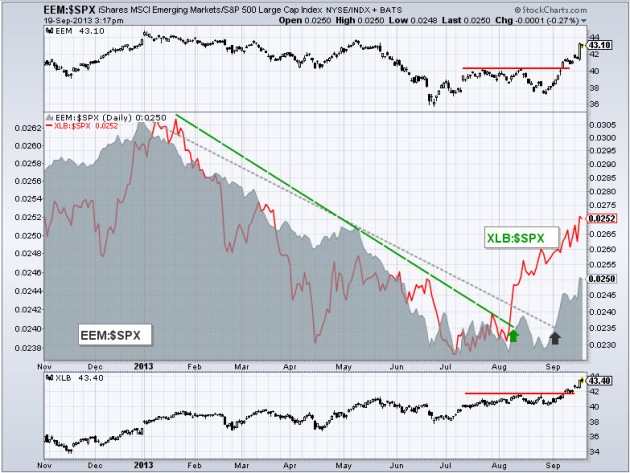Rich Dad Stock Blog
Free Information to Help You Build Wealth in the Stock Market
Tag Archives: rich dad
Introduction to Options – Put Options

Rich Dad Education trainers take their lifelong trading experience and pass it along to students through various educational offerings. This experience helps prepare students to approach the market in a logical and consistent manner. It also helps students identify and take advantage of a variety of market conditions. Identifying bearish conditions and knowing when to enter the market can be a highly profitable endeavor.
Put Options
The buying of put options is a simple and straightforward approach in which a new trader can take advantage of bearish trade setups. Here is a basic overview of put options:
- You can buy a put: puts are bought on stocks that traders believe will go down in price.
- Your entry into a trade using puts should be determined by your technical and charting knowledge of the stock.
- Buying puts does not benefit from time decay.
- You have theoretically an unlimited reward from buying puts to the point where the stock goes to zero.
Buying Put Trade Setups
Rich Dad Education students are trained to identify bearish trade setups. They are never forced to rely on guessing or their gut. Traders who simply buy put options because they are sure the market is going down based on their feelings exhibit extreme novice behavior and can be severely punished by the market.
Here are some technical criteria to look for when attempting to identify potential bearish trades.
Strong Areas of Resistance
When you identify strong areas of resistance, you gain solid knowledge of how the stock may potentially behave. Strong areas of resistance often keep the price from going above that price area and can give you valuable knowledge on when you should enter a bearish trade. Traders often attempt to identify a stock in a bearish trend and then enter into the trade via buying a put when the stock hits one of these areas of resistance and then starts to head down again.
Bearish Trends
When buying puts, it is wise to be trading in the direction of the trend. Strong bearish trends enhance the probability of a winning trade. Traders that attempt to buy puts when a stock is going up can have occasional success by identifying short-term halts in the trend; however, this is similar to fish swimming upstream. Traders can simplify their lives and trading by going with the trend as this tends to increase the probability of success.
Overall Market Trend
If the broad markets are in a downtrend then this helps the chances that the stock might get pulled along with the trend. The same logic of swimming upstream applies. Don’t try and be the smartest trader in the world by identifying narrow windows where you can trade against the trend. Simply go with the trend and enjoy the highly profitable results.
Breakouts of Strong Areas of Support
It is a well-known fact in the trading world that stocks fall faster than they rise. Identifying when these fast falling periods may occur can be extremely profitable. When the price of a stock falls through a price area that had previously demonstrated strong support, the results can often be quite dramatic. It is important to learn to identify these areas of support. Once these price areas fail, you need to develop trading rules that help determine when you should enter the trade. The buying of a put can be the trading instrument you use to profit in these scenarios.
These are just a few of the basic, yet fundamental things you should look for in determining whether it is appropriate or not to enter a bearish trade. There are many bearish strategies that can be used to profit from these trade setups and the buying of a put is one of them. The next article in this Rich Dad Education Options Series will cover another of the four option building blocks, the selling of calls.
Share this:
- Click to email a link to a friend (Opens in new window)
- Click to share on Facebook (Opens in new window)
- Click to share on Twitter (Opens in new window)
- Click to share on LinkedIn (Opens in new window)
- Click to share on Pinterest (Opens in new window)
- Click to share on Tumblr (Opens in new window)
- Click to share on Pocket (Opens in new window)
- Click to share on Reddit (Opens in new window)
Jack of All Trades

With the bevy of information at a trader’s fingertips, many climb aboard the merry-go-round of learning never to depart. They reason that improving trading results is inextricably linked to acquiring more knowledge. If one can develop mediocre trading habits after reading one stock book, surely they’ll do better after reading five. If one attains a modicum of success by trading a simple long stock strategy, surely they’ll see improvement if they also learn the nuances of shorting, options, spreads, and futures. As they energetically jump from one topic to the next, one strategy to another, I wonder if some traders are passing up a more rewarding path. I wonder if by putting a premium on the breadth of their knowledge, they’re losing sight of the depth.
Is it better to know a little about a lot, or a lot about a little?
I’d argue the latter, particularly with trading. Better to be great at a few strategies than mediocre at numerous ones. I suppose in the long run the ideal outcome is to know a lot about a lot, but such an endeavor takes time and is achieved piecemeal.
Twitter plays an interesting part in this process. It reveals one’s discipline or lack thereof. Trade ideas are a dime a dozen and it can be seriously tempting to simply follow trades at random. If one isn’t a careful curator or disciplined observer their portfolio can become a hodgepodge of day, swing, and position trades with stock and option positions galore.
If you’re planning on attending multiple Rich Dad Education Elite trainings be sure to take adequate time between each one to practice the techniques and strategies learned in the previous class. That way you’re taking full advantage of your education and having proper preparation for your next step in the learning continuum.
In your knowledge acquisition quest, don’t sacrifice specialization. Don’t become a jack of all trades and master of none.
Tyler Craig, CMT
Rich Dad Education Elite Training Instructor
Learn more about our Elite Stock Courses here.
Share this:
- Click to email a link to a friend (Opens in new window)
- Click to share on Facebook (Opens in new window)
- Click to share on Twitter (Opens in new window)
- Click to share on LinkedIn (Opens in new window)
- Click to share on Pinterest (Opens in new window)
- Click to share on Tumblr (Opens in new window)
- Click to share on Pocket (Opens in new window)
- Click to share on Reddit (Opens in new window)
Degrees of Separation
Source: Wikipedia
“Six degrees of separation is the theory that everyone and everything is six or fewer steps away, by way of introduction, from any other person in the world…”
In the world of relationships, six degrees of separation is an entertaining game revealing how two persons of interest are connected. It’s an activity requiring a healthy dose of creativity and a detective-like eye for hidden clues. Often two items appearing unrelated on the surface can be connected after further digging.
In the world of Wall Street investors, curiosity often leads them on a search to find out how two different stocks or asset classes may be linked. This search is really a two part process. The first step is measuring the extent to which two different assets are correlated which can be done easily using a correlation indicator (recently discussed here). The second step involves discovering why both assets may be linked which is usually just a byproduct of studying the underlying fundamentals of their individual markets.
Consider the following example using two seemingly unrelated sectors of the stock market – Basic Materials (XLB) and Emerging Markets (EEM). The Basic Material sector is a basket of stocks in similar industry groups like chemicals, iron & steel, and metal mining. Emerging Markets consists of a broad group of nations around the world like Brazil, Russia, India, and China.
In seeking the link between both sectors we could construct a logic chain of sorts:
- Basic Materials are heavily weighted toward the commodities market.
- Commodity prices are influenced by investors’ perception that the global economy is healthy – particularly those countries that are big commodity importers or exporters like China and Brazil.
- China and Brazil are two of the largest countries in the Emerging Markets sector.
- If China, Brazil, and their fellow brethren in the emerging markets space are strong, then demand for commodities will be strong which, in turn, will drive up commodity related stocks thereby boosting the Basic Material sector.
The positive link between Emerging Markets and Basic Materials can be seen in the following chart:
From top to bottom we have the price chart of EEM, the relative strength of emerging markets (EEM:$SPX – gray area chart) overlaid with the relative strength of basic materials (XLB:$SPX – red line), and finally the price chart of XLB. Throughout the first seven months of the year both XLB and EEM were underperforming the S&P 500 Index. Recently, however, both have changed their stripes from market laggards to leaders. The Basic Material sector’s relative strength turned up in early August (green arrow) followed closely by a reversal in the relative strength of Emerging Markets (black arrow).
As goes one, so goes the other.
Tyler Craig, CMT
Rich Dad Education Elite Training Instructor
Learn more about our Elite Stock Courses here.
Share this:
- Click to email a link to a friend (Opens in new window)
- Click to share on Facebook (Opens in new window)
- Click to share on Twitter (Opens in new window)
- Click to share on LinkedIn (Opens in new window)
- Click to share on Pinterest (Opens in new window)
- Click to share on Tumblr (Opens in new window)
- Click to share on Pocket (Opens in new window)
- Click to share on Reddit (Opens in new window)
Introduction to Options – Call Option Setups

In the previous article in this Rich Dad Education series, call options were discussed. The buying of call options represents one of four core building blocks for all option strategies. While traders who haven’t received financial education might simply buy a call option because they “think the stock will go up,” Rich Dad Education students are trained to identify high probability trade setups. Once a highly bullish trade setup is identified, the call option is one potential trading instrument that can be used to take advantage of this setup.
Buying Call Options Review:
- You can buy call options – calls are bought on stocks that investors believe will go up in price.
- Your entry into a trade using calls should be determined by your technical and charting knowledge about the stock.
- Buying a call is a debit trade – you must pay the premium.
Setups to Identify for Buying Calls
You greatly enhance the probability of a winning trade by identifying certain bullish technical setups before buying a call option. Rich Dad Education students learn technical analysis through elite trainings and the mentoring program. Once a trader has a strong grasp of technical analysis, then their ability to identify and take advantage of high probability bullish trade setups greatly increases.
Here are just a few bullish technical criteria that can help identify potential bullish trades. This knowledge gives a trader a significant edge over someone who simply buys a call option because “they think the price is going to go up.”
Strong Areas of Support
– When you identify strong areas of support, then you have identified a price area that the stock may have difficulty going below. Strong areas of support give the trader highly valuable knowledge of where the short-term floor of the stock may be in order to place bullish trades based on this knowledge. Buying calls in uptrends that bounce off short-term areas of support on high volume is a common short-term trade involving calls.
Bullish Trends
– When buying calls you need to be trading in the direction of the trend. Strong bullish trends enhance the probability of a winning trade. Many novice traders buy calls when stocks are going up in the hope that stock will continue to go up. Traders with knowledge of technical analysis take this one step further by properly identifying that an uptrend is not only occurring but shows strong signs that it will continue to do so. At a minimum, you should not buy calls while a stock is in a downtrend in the hopes that it will reverse course. You should wait until you have technical signals that a reversal is occurring.
Overall Market Trend
– If the broad markets are in an uptrend, then this increases the chance that the stock might get pulled along with the trend. Buying calls at key entry points when a stock and the overall market are in an uptrend greatly puts the odds in your favor.
Breakouts Through Strong Areas of Resistance
– When the price of a stock breaks through a strong area of resistance, this is often a signal that significant upward price movement is about to occur. Oftentimes call options are bought when price breaks through these areas of resistance in order to profit on this price movement. A trader should adhere to their entry rules when such a breakout occurs.
These are just a few factors to look for before buying a call option on a stock. Technical analysis provides the logic to help guide you in making your decision. You may choose to buy call options to take advantage of the trade setups you find. The next article in this Rich Dad Education series will discuss the buying of put options – the instrument that you can use when you see trade setups that signal that the market may be going down.
Share this:
- Click to email a link to a friend (Opens in new window)
- Click to share on Facebook (Opens in new window)
- Click to share on Twitter (Opens in new window)
- Click to share on LinkedIn (Opens in new window)
- Click to share on Pinterest (Opens in new window)
- Click to share on Tumblr (Opens in new window)
- Click to share on Pocket (Opens in new window)
- Click to share on Reddit (Opens in new window)
The Land of Story Seekers

Inherent in our DNA is a natural fascination with stories; a need for a narrative offering easy explanations and digestible answers. No doubt this curiosity acts as an internal impetus driving all of us to seek out answers to intriguing questions. While it paves the way for new discoveries and intellectual leaps, it can also lead the gullible masses to gobble up whatever is being peddled by the latest guru. In the land of story seekers, the master storyteller is king. Even if his persuasive tales are riddled with errors.
In the world of trading I wonder if this natural attraction to stories lies at the heart of a mistake which I suspect is quite common – the continuous attempt to explain market movements. Searching for the “why” behind the “what”, as it were; the perpetual need to determine why some asset rallied or fell on any given day.
From an economics standpoint the answer to such a question is actually quite simple. Prices dropped because supply exceeded demand or prices rose because demand exceeded supply.
Not satisfied? Well, head on over to your favorite financial media site and dollars to donuts you’ll find some pundit opining on a news item or compelling reason that ostensibly caused the price move. As if said pundit could actually enter the minds of the millions of investors that bought or sold the security in question and figure out their true motivations.
Those who focus on the underlying theory behind why a particular asset is moving in one direction or the other tend to be much slower to react when adverse conditions arise. They stubbornly cling to their version of the story, unwilling to face an alternate reality. What should happen or what should have happened is a weak consolation prize to what IS happening.
Stories are a lousy substitute for a chart. An overemphasis on building theories to forecast what should be happening leads many to under-emphasize the actual analysis of what is happening in the here and now.
As a trader I find little, if any, utility from the majority of news articles out there. While sometimes entertaining, they rarely lead to the making of a better trading decision. And don’t confuse the ability to spin a compelling tale with successful investing prowess. If connecting the economic dots of intermarket relationships was a prerequisite to success, the savviest traders would be professors from academia.
In an arena such as ours where timing is everything, the ability to analyze what is happening is altogether superior to crafting a palatable theory on why it is happening.
Tyler Craig, CMT
Rich Dad Education Elite Training Instructor
Share this:
- Click to email a link to a friend (Opens in new window)
- Click to share on Facebook (Opens in new window)
- Click to share on Twitter (Opens in new window)
- Click to share on LinkedIn (Opens in new window)
- Click to share on Pinterest (Opens in new window)
- Click to share on Tumblr (Opens in new window)
- Click to share on Pocket (Opens in new window)
- Click to share on Reddit (Opens in new window)
